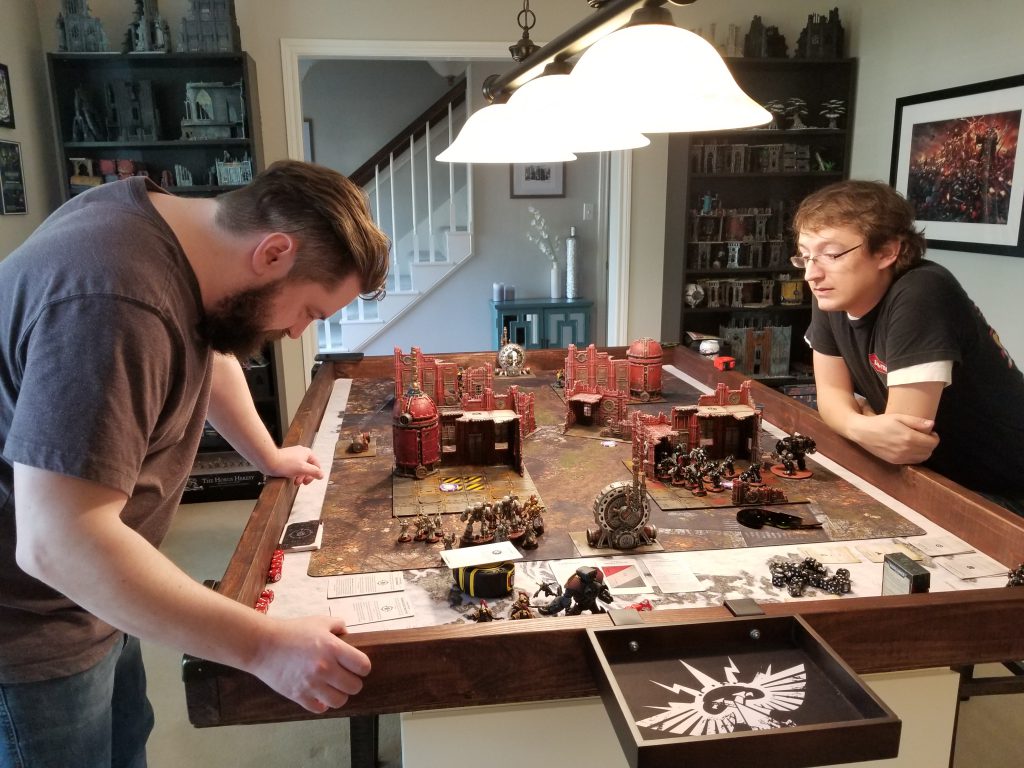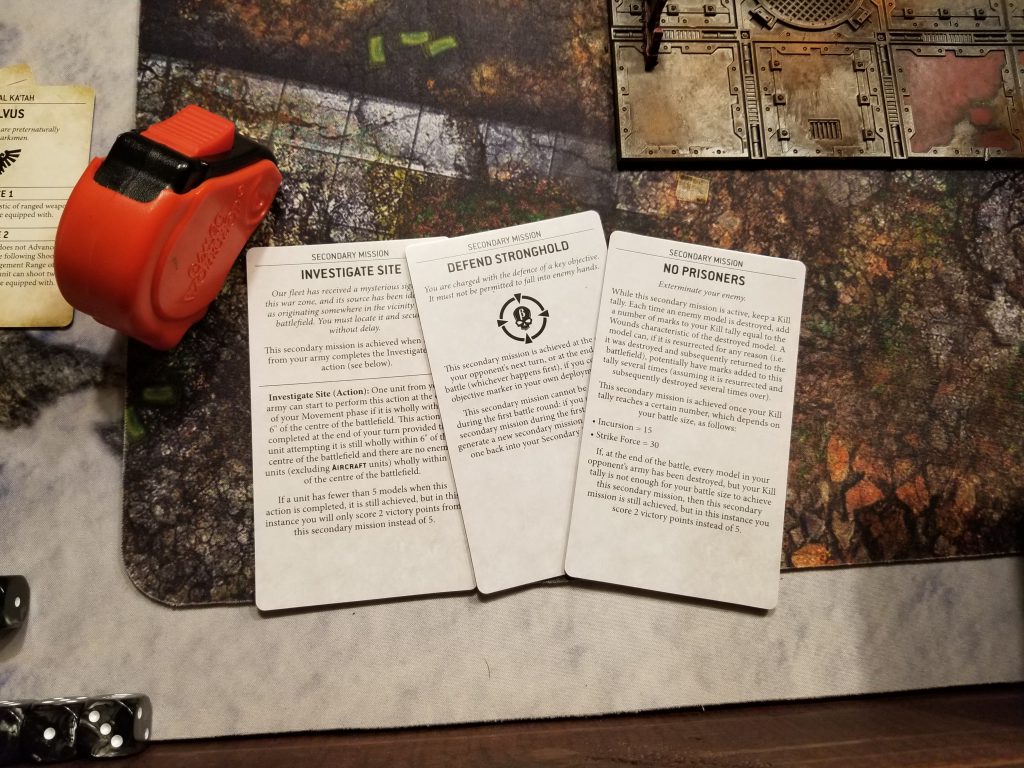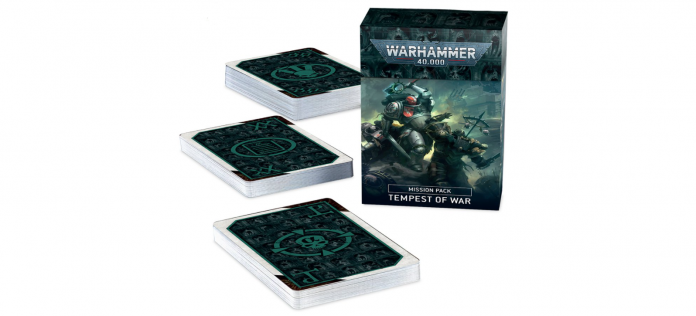Before we start, we’d like to thank Games Workshop for sending us a preview copy of the Tempest of War Mission Pack for review purposes.
Games Workshop never really nailed down the “three ways to play” they rolled out in 8th edition. Sure, we got Open, Narrative, and Matched Play but Open play had little to no support save the Eternal War deck while Narrative play tended to feature a lot of gratingly unbalanced (and unfun) scenarios, outside of the underrated Urban Combat expansion. What we were left with was Matched Play missions, which seemed to work fine for casual players who wanted to play with points but less so for competitive players, leading to the ITC/NoVA style missions that tended to dominate competitive play or the mixed ETC format using Maelstrom decks.
When 9th edition released, Games Workshop shored this up considerably, replacing Narrative play with the excellent – if complicated – Crusade mode, and replacing its Matched play missions with secondary-driven tournament missions that see regular updates. These are both substantial improvements for campaign and competitive players over the 8th edition formats, and each caters much more effectively to the group they’re designed for.
There’s one large group left out here, however: The large number of casual players who get in around 6-12 games per year. For these players Crusade is often too involved, requiring too much time and bookkeeping (and a larger friend group), while GT missions are too complicated, requiring they build armies around missions and make tactical decisions they aren’t prepared to make. This is a group for whom Maelstrom of War were a good compromise, offering dynamic missions that rarely got stale but didn’t need a ton of forethought.
So if you’ve found yourself turned off by the competitive missions in the GT pack (and the Eternal War missions are just a worse, less-balanced version of those), then I’ve got great news: The Tempest of War deck is exactly what you’ve been waiting for. And if you want my hot take, it’s that Tempest of War is also a pretty compelling format for competitive play, too.
The Tempest of War Deck
Let’s cover the basics first: The Tempest of War Deck Box is larger than you’d expect, but has more than you’d expect in it as well. The cards are longer than standard playing cards – my least favorite thing about them, since it makes it impossible to sleeve them – and the box comes with a ton of stuff:
- Six punch-out 40mm Objectives. These aren’t numbered. That’s a good thing, and we’ll talk about it later.
- A Folding Rulebook. This card-sized folding rules pamphlet covers the basic setup and process for Tempest of War games. Most of this is the same as GT Nachmund missions (including the restrictions on subfaction keywords and the change to the Superheavy Auxiliary Detachment), with some differences we’ll detail below.
- Six Deployment Map Cards. These cards allow you to randomly determine the mission’s deployment map. Four of them are taken directly from the standard GT Missions, and will be familiar to veterans as Dawn of War, Hammer and Anvil, Search & Destroy, and Priority Target deployments, while the remaining two are similar to Vital Intelligence and Spearhead Assault and are likely to be the most controversial of these (though worth noting that none of these approach the insanity of the Open War deck options).
- Two Stratagem Cards. These cards go to each player to help them remember the New Orders Stratagem, which for 1 CP will allow them to discard an active Secondary mission and immediately generate a new one. This is a fine idea, though as these cards are also larger, they will stick out in any deck of faction datacards, which stinks.
- Twelve Mission Rules Cards. These will be familiar to Open War deck players – each Tempest of War game has players generate one mission rule for the game. Unlike the Open War deck, these are pretty reasonable effects. They range from “no special rule this game” to “add a sixth objective marker” to reducing the cost of putting units into reserves, making players roll for reserves to arrive, or having players only generate CP for being battle-forged if they control the objective marker in their deployment zone. Only one of these causes mortal wounds and it’s manageable.
- Six Primary Mission Cards. These cards determine how players score for holding objective markers during the game. The most recognizable card here is Take and Hold, which players will recognize as the “vanilla” format for 9th edition missions, where players score 5 VP each for holding one/two/more objectives than their opponents at the end of their command phases, and the player going second scores their turn 5 points at end of turn. The five other modes have different point rewards and may award points for killing units, holding objectives in no man’s land, destroying objectives, or introduce “lock-in” mechanics for objective control.
- TWO decks of 20 Secondary Mission Cards. This is the maelstrom component to the game, and one of the best things about the box is that it comes with two decks to play with, so you only need one set to sit down and play with a friend. I’ll go into more detail on these in a moment.

Playing Tempest of War Games
The process for playing Tempest of War games is pretty simple. Play progresses here just like it does in Matched Play, only instead of referring to the mission briefing for the Deployment Map and mission parameters, you’ll randomly generate a battlefield using the Deployment Map cards, then generate one Primary mission and one Mission Rule from those decks. Once that’s done, players alternate placing objective markers – four for Incursion games and five for Strike Force (plus one more if the mission rule dictates), with one in each deployment zone and the remainder in no man’s land, more than 6″ from a table edge and 9″ from another marker.
RobNote: This is done starting with the youngest player, which is one of the few bad ideas in here. I’d recommend moving this to after the Attacker/Defender roll-off and let the Defender place the first Objective Marker after picking a Deployment Zone.
At this point, the players figure out attacker/defender, declare reserves & transports, deploy, and roll for first turn as normal.
Secondary Missions
At the start of each player’s Command phase, the player whose turn it is draws cards from their Secondary mission card until they have three cards in hand. These are the active objectives for that player. Each time a player achieves a secondary mission, they discard it and score VP (usually 5 per card, though some give other values). At the end of each player’s turn, they can discard any of their active secondary mission cards they want. Once a player runs out of cards, they can’t generate any more secondary missions. You can score a maximum of 45 points from secondary missions during a game, part of the familiar 45-45-10 rubric.
The Secondary Missions in the deck give you a lot of options, and most of them will be familiar to players who have spent time with the GT missions. Here are a few examples:
- Behind Enemy Lines is achieved at the end of your turn if you have two or more non-AIRCRAFT units in your opponent’s deployment zone. If you only have one unit left, then this secondary is only worth 2 VP.
- Grind Them Down has both players keep an Attrition tally for each enemy unit destroyed, and at the end of each opponent’s turn you compare tallies. Have a higher tally than your opponent for any of these checks and you score 5 VP.
- No Prisoners has you keep a kill tally that tracks the number of wounds for each enemy model you destroy. Get that tally to 15 in an Incursion game or 30 in Strike Force and you score 5 VP. If you table your opponent before you achieve the tally, you net 2 VP instead.
- Secure No Man’s Land awards you 5 VP for holding two or more objectives in No Man’s Land. If you only have one unit left, you score 2 VP instead.
You may notice that these all have scaling factors on them; that’s one of the best parts of these secondary missions – they’ve all been designed with both the Incursion and Strike Force game sizes in mind, and they take into account armies that can’t achieve them. For example the Raise Banner secondary mission gives you an action to complete that can only be done by an INFANTRY unit, but if your army has no INFANTRY, the card instructs you to discard it immediately and generate another card, ensuring it won’t sit dead in your hand if you’re playing Knights or have lost all your infantry.
The deck also has a notable lack of missions that say “Capture Objective X,” where X is a number 1-6. These made up half of the old Maelstrom of War decks and were one of the worst aspects of maelstrom – all too often games could be decided by one player managing to draw all of the cards that score them VP for capturing an objective they already hold, while their opponents get cards asking them to capture the heavily-defended objective in their opponent’s deployment zone. Not the case here – every secondary mission is notably unique and interesting and they’re all pretty fair asks for most armies and in most game situations.
The decks here are 20 cards each, which is enough to give players variety and some unpredictability without feeling completely random. You’ll need to score 9 of them in an average game to max out your secondary missions, and that feels like a tall order in most games. Capping the secondary missions at 5 VP also creates some interesting dynamics where players have to weigh the risk-vs-reward of holding onto a given card, and opens up some interesting tactical decisions that will favor more thoughtful players.

Final Verdict
We received the Tempest of War decks without knowing what to expect; and since opening the deck and reviewing the cards I can say that I like them more the more I read them and think about how they’ll play. The decks are well made and the fact that the pack comes with two secondary mission decks is perfect; previous editions forcing players to buy their own cards significantly hampered more casual players’ ability to sit down and get the most out of Maelstrom games.
If you’re a casual player who didn’t like the GT missions or felt they were too complicated, or if you just don’t like building around or picking secondaries, Tempest of War is a great alternative. The secondaries are sensible and dynamic without feeling like you never have control over the game. They reward prepared players with versatile armies. At the same time, there’s just enough randomness here that players who are so inclined will probably feel like they can shrug off a loss by blaming the cards.
If you’re a competitive player looking to mix things up, I’d also recommend this mission pack, and if anyone in the WTC/ETC is reading and wondering if this is a great replacement for the old mixed Maelstrom format those events used, I’d say that it absolutely is. You’ll want to create a couple of houserules around things like objective placement order, and you may want to evaluate which objective map and mission rule cars you use, but otherwise this mission format has a lot to offer and will likely create some great competitive play experiences. I also think these missions are much, much better and more well-suited to competitive play at the 1,000 point game level (Incursion) than the GT missions, where many secondary objectives do not scale down at all.
Put simply, Tempest of War is the best version of Maelstrom Games Workshop has ever produced. If you’re a casual player who wants a good format for matched play that’s easier to pick up and jump into than the GT missions, this card pack is a must-buy. If you’re a competitive player looking to mix things up or try a new format, this is also worth looking at. It’s lowkey one of the best, most well thought-out and designed rules products I’ve seen from GW in the last two editions and it’ll be a damn shame if it flies under the radar.
Have any questions or feedback? Drop us a note in the comments below or email us at contact@goonhammer.com.


